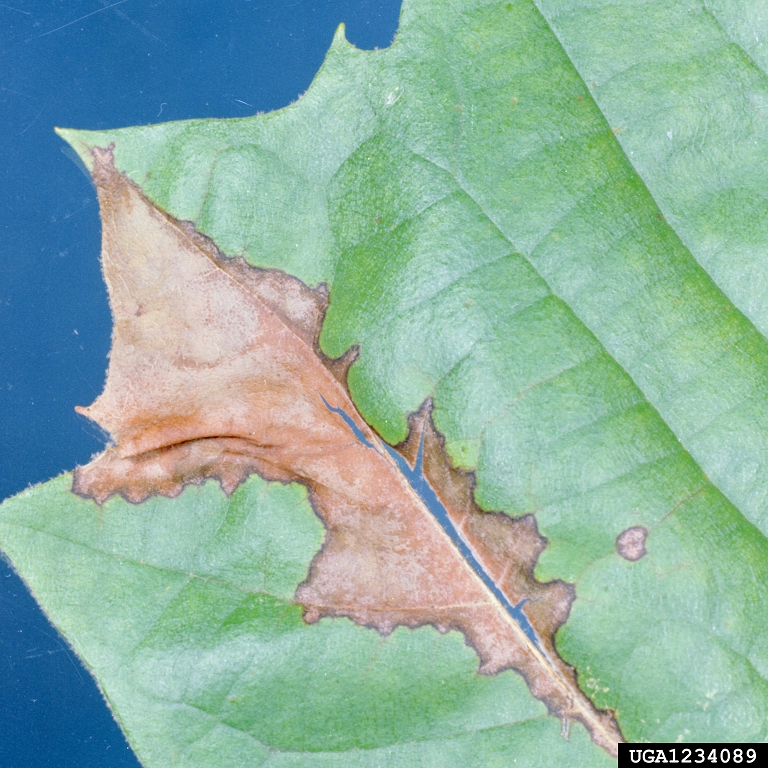 Sycamore Anthracnose - May 10, 2017 Jeff Schalau, Agent, Agriculture & Natural Resources University of Arizona Cooperative Extension, Yavapai County The Camp Verde Cooperative Extension Office has received several calls regarding a problem with Arizona sycamore trees (Platanus wrightii). Some of these trees have lost most of their new growth and those leaves have fallen to the ground. The leaves are curled up and in some places, the major leaf veins are brown (necrotic). This fungal disease is called anthracnose (also called leaf, twig or shoot blight). Anthracnose is favored by cool, moist weather in the spring and rarely causes permanent damage to the tree. Anthracnose fungi overwinter in infected twigs. In spring many microscopic spores are produced and are spread by splashing rain or sprinkler water to new growth where they germinate; the fungus enters the leaves and newly expanded twigs. If moist conditions prevail, a successive generation of spores is produced in the infected parts of new leaves. If conditions become dry, the progress of the disease slows and becomes negligible during the summer. The affected trees should produce a new flush of healthy leaves following the initial defoliation. We had cool, moist spring weather conditions this year and should have anticipated the anthracnose. However, it is not a serious problem in our area. If you are considering a new planting of Arizona sycamores, give them plenty of space to maximize air circulation and increase sunlight, both of which facilitates faster drying of leaf surfaces when trees are fully grown. Arizona sycamores are very large when mature, so they should probably be planted 40 to 50 feet apart. Once these foliar symptoms develop or become severe, anthracnose cannot be effectively controlled during the current season. Rake and dispose of fallen leaves and twigs during the growing season and during the fall. If necessary, prune during winter to increase air circulation in the canopy and remove the previous season’s infected twigs and branches. No fungicides are available to control sycamore anthracnose. Chronically infected trees develop cankers on the twigs and branches at the base of blighted leaf clusters. A canker is a sunken, dead area visible on a stem, branch, or trunk and are active during wet cool springs and produce spores that spread to neighboring twigs, leaves, and other sycamore trees. Small, black fruiting bodies of the anthracnose fungus appear in the discolored bark of dead twigs and branches near the canker. Repeated annual killing of twigs results in clusters of old dead twigs and live branches creating what are called “witches’ brooms.” The cankers restrict water and nutrient movement to the leaves resulting in twig die-back, chlorosis and scorch on leaves, and can even kill larger branches. When feasible, prune infected twigs and branches during fall or winter. Severe pruning of larger diameter branches is not recommended for most types of trees because it triggers bushy growth of water sprouts, which are poorly attached to the trunk and may cause other problems for the tree. To stimulate vigorous growth of trees severely affected by anthracnose, lightly fertilize after the leaves open and spring rains have stopped and avoid irrigation systems that wet the leaves. No fungicides are available to control active cases of sycamore anthracnose. However, fungicide applications can prevent subsequent outbreaks within a single growing season. Fungicides registered for the control of sycamore anthracnose include chlorothalonil, thiophantemethyl, and copper fungicides. The recommended fungicides usually are readily available to homeowners at local nurseries and garden centers. Always read label directions. Labels may be updated yearly or more often. If the product label does not include anthracnose on ornamentals (shade trees), use an alternative product. Planting less susceptible tree species is another strategy to manage anthracnose. The London plane (Platanus acerifolia) is a hybrid making it less susceptible to anthracnose and a good choice for our area. The London plane cultivars, ‘Bloodgood’, ‘Columbia’ and ‘Liberty’ are resistant to anthracnose. Remember that sycamores are large trees and require regular irrigation if they are not growing in a floodplain or riparian area. This makes them less suitable for small lots and upland areas. On the positive side, sycamores tend to be long-lived, have attractive bark, and a graceful growth form. At any rate, sycamore anthracnose has been seen in our area before and we are likely to see it again. I have linked a publication and photo of foliar symptoms below. Follow the Backyard Gardener on Twitter – use the link on the BYG website. If you have other gardening questions, call the Master Gardener help line in the Camp Verde office at 928-554-8992 or e-mail us at verdevalleymg@gmail.com and be sure to include your name, address and phone number. Find past Backyard Gardener columns or provide feedback at the Backyard Gardener web site: http://cals.arizona.edu/yavapai/anr/hort/byg/. Additional Resources  Symptoms of sycamore anthracnose (Apiognomonia veneta) on London Plane leaf (Clemson University - USDA Cooperative Extension Slide Series, Bugwood.org).
Symptoms of sycamore anthracnose (Apiognomonia veneta) on London Plane leaf (Clemson University - USDA Cooperative Extension Slide Series, Bugwood.org).Syacamore Anthracnose Colorado State University Extension extension.colostate.edu/docs/pubs/garden/02930.pdf |